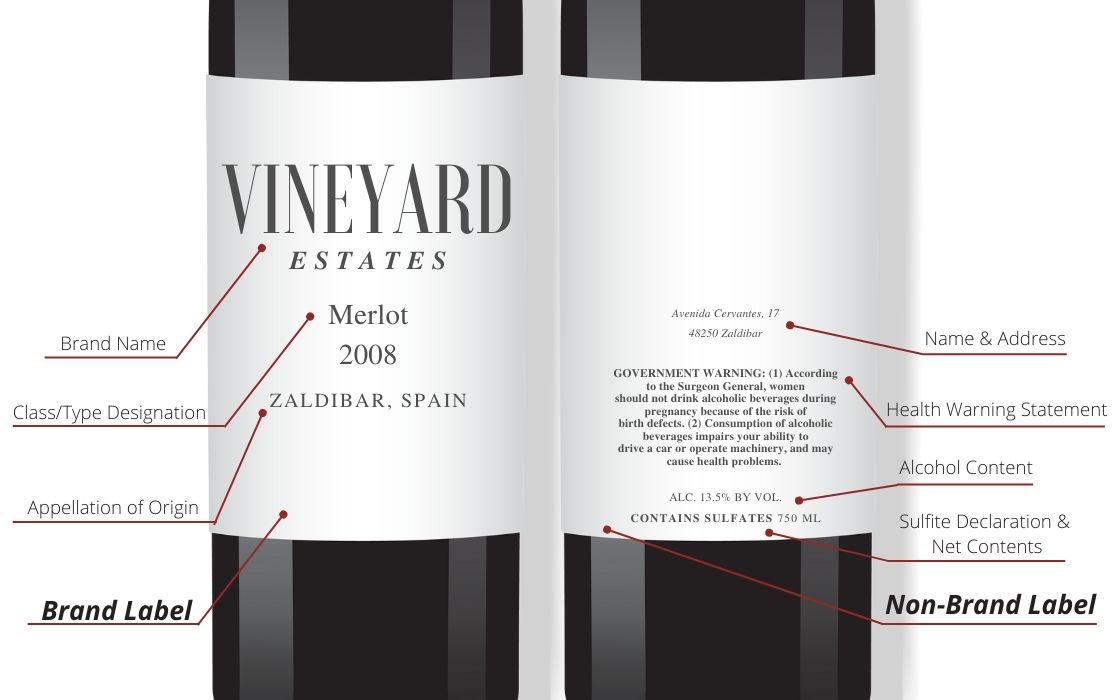Labeling Wine Bottles: Required vs. Optional Information
Making your first wine label or perfecting the design of your current wine label is made possible by digital label printing. Stunning labels are fashionable and functional necessities that show off your brand while giving customers necessary health and industry information. At BR Printers, we help liquor distributors and wineries print eye-catching wine labels. Before heading to production, there are a few steps to complete. How are you supposed to know what information to put on a wine label? We’ve got you covered.
What information goes on a wine label?
Before your labels hit the printing press ensure your labels align with TTB wine and beer label requirements. Some information is optional, and some information is required. Taken a step further, some of the required information is only required if it’s applicable to your location or type of wine.
As you can see in the table above, certain info is required on the brand label. What’s a brand label? The diagram below shows the brand label and the information required on that wine bottle label. Once you’ve gathered the required information, decide what optional information you’ll display. Adding optional information could be beneficial to customers or it could make your labels busy and difficult to read on the shelves. This choice is up to you!
Required Information
On Brand Labels
- Appellation of Origin: Where the fruit or product was grown.
- Brand Name: The name that the wine is marketed under which could be the name of the bottler, packer, or importer is there isn’t a specific brand name for the wine.
- Class or Type Designation: Wine is split up into classes and types. Examples of wine classes are Grape Wine, Aperitif Wine, Citrus Wine, and Fruit Wine. Wine is also split based on one designation. Common examples of wine designations are Dessert Wine, Red Wine, and White Wine.
- Percentage of Foreign Wine (if applicable): This only applies if wine is a blend of American wine and foreign wine. In that case it is required to include what percentage of wine is foreign.
On Any Label
- Alcohol Content: The wine’s alcohol content that is calculated as the percentage of alcohol by volume must be displayed.
- Color Ingredient Disclosures: If FD&C Yellow No.5, cochineal extract, or carmine are added to the wine, that must be on the label.
- Country of Origin: If wine is imported, the country of origin must appear on the wine label.
- Health Warning Statement: The type size and legibility of the government warning is by the TTB. The copy must be as follows:
- GOVERNMENT WARNING: (1) According to the Surgeon General, women
should not drink alcoholic beverages during pregnancy because of the risk of
birth defects. (2) Consumption of alcoholic beverages impairs your ability to
drive a car or operate machinery, and may cause health problems.
- GOVERNMENT WARNING: (1) According to the Surgeon General, women
- Name and Address: Name and address specifications vary if the wine is imported or American.
- Net Contents: This information shares how much wine is in the bottle or container.
- Sulfite Declaration: Similar to the health warning statement, the type size and legibility of the sulfite declaration is specified by the TTB.
Optional Information
- American Viticultural Areas (AVA): An American Viticultural Area is an appellation of origin stated on wine bottles. These areas are geographically known to affect how the grapes are grown. AVAs are established by the TTB.
- Grape Variety Designations: A grape variety name isn’t the name of the grape, but instead it’s an approved name for grape blends.
- Gluten Content Statements: Distributors and wineries that produce truly gluten-free wine can choose to include a “gluten-free” statement on their bottle label, but it’s not required.
- Major Food Allergen Labeling: It is optional to state that your wine may include major food allergens.
- Statements Related to Nutrient Content, Serving Facts, Alcohol Facts, and Sugar Content: This type of content could include calories or carbohydrates, protein, and fat per serving.
- Organic Claims: Adding an organic claim to your wine bottle label might be a great strategy for your product placement and marketing efforts, as long as it aligns with the rules of that the United States Department of Agriculture finalized with the National Organic Program.
- Personalized Labels:Custom wine labels often include anniversary dates, event titles, names, logos, and more. If you’re selling wine that gives customers the option to customize their label, you still must meet all the lbel information requirements.
Time to Get Printing
Now that your labels align with requirements, they’re ready to print. Fill out our contact form and we’ll connect you with a labels rep to help you make the right label production choices based on the uniqueness of your product, the quantity you need, and how fast you need them. Find more details and requirements from the TTB (U.S. Department of the Treasury, Alcohol and Tobacco Tax and Trade Bureau).
Based in San Jose, CA, BR Printers is a provider of print and marketing services. We print shipping labels, medical labels, food labels, and more! Our print and marketing capabilities offer solutions for every business in every industry.

